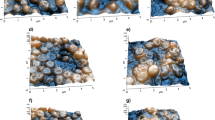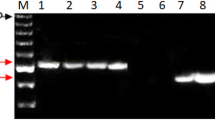Abstract
Objective
The aim of this study was to determine whether different antiseptic mouthrinses show different penetration kinetics into Streptococcus mutans biofilms.
Materials and methods
The biofilms, grown on glass-based dishes, were exposed to one of four mouthrinses containing chlorhexidine digluconate, essential oil, cetylpyridinium chloride, or isopropylmethylphenol. Then, penetration velocities were determined by monitoring fluorescence loss of calcein AM-stained biofilms with time-lapse confocal laser scanning microscopy. Bactericidal activity was assessed with fluorescent bacterial viable cell (Live/Dead) staining and viable cell counts. Bacterial detachment after the mouthrinse exposure was determined by measuring fluorescence reduction of SYTO9-stained biofilms.
Results
The essential oil-containing mouthrinse showed significantly faster penetration velocity than the other mouthrinses (ANCOVA and Bonferroni test, p < 0.05). However, even 5 min of exposure left the biofilm structure almost intact. After 30 s (consumer rinsing time) of exposure, the essential oil-containing mouthrinse showed the highest log reduction of viable cells (2.7 log CFU) measured by Live/Dead staining, and the mean reduction of total viable cells was 1.41 log CFU measured by viable cell count.
Conclusions
The essential oil-containing mouthrinse showed the best penetration. Within 30 s of exposure, however, no mouthrinses injured all the microorganisms and all mouthrinses left the biofilm structure nearly intact.
Clinical relevance
The mouthrinses tested showed different levels of biofilm penetration. The essential oil rinse was superior to other rinses by all three of the in vitro measurements performed.





Similar content being viewed by others
References
Allaker RP, Douglas CWI (2009) Novel anti-microbial therapies for dental plaque-related diseases. Int J Antimicrob Agents 33:8–13
Marsh PD (2010) Controlling the oral biofilm with antimicrobials. J Dent 38(Suppl 1):S11–S15
Jeon JG, Rosalen PL, Falsetta ML, Koo H (2011) Natural products in caries research: current (limited) knowledge, challenges and future perspective. Caries Res 45:243–263
Socransky SS, Haffajee AD (2000) Dental biofilms: difficult therapeutic targets. Periodontol 2000 28:12–55
Kolenbrander PE, Andersen RN, Blehert DS, Egland PG, Foster JS, Palmer RJ Jr (2002) Communication among oral bacteria. Microbiol Mol Biol Rev 66:486–505
Marsh PD (2005) Dental plaque: biological significance of a biofilm and community life-style. J Clin Periodontol 32(Suppl 6):7–15
Stewart PS (2003) Diffusion in biofilms. J Bacteriol 185:1485–1491
Thurnheer T, Gmur R, Shapiro S, Guggenheim B (2003) Mass transport of macromolecules within an in vitro model supragingival plaque. Appl Environ Microbiol 69:1702–1709
Kim J, Pitts B, Stewart PS, Camper A, Yoon J (2008) Comparison of the antimicrobial effects of chloride, silver ion, and tobramycin on biofilm. Antimicrob Agents Chemother 52:1446–1453
Baffone W, Sorgente G, Campana R, Patrone V, Sisti D, Falcioni T (2011) Comparative effect of chlorhexidine and some mouthrinses on bacterial biofilm formation in titanium surface. Curr Microbiol 62:445–451
Kaneko Y, Thoendel M, Olakanmi O, Britigan BE, Singh PK (2007) The transition metal gallium disrupts Pseudomonas aeruginosa iron metabolism and has antimicrobial and antibiofilm activity. J Clin Invest 117:877–888
Davison WM, Pitts B, Stewart PS (2010) Spatial and temporal patterns of biocide action against Staphylococcus epidermidis biofilms. Antimicrob Agents Chemother 54:2920–2927
Banin E, Brady KM, Greenberg EP (2006) Chelator-induced dispersal and killing of pseudomonas aeruginosa cells in a biofilm. Appl Environ Microbiol 72:2064–2069
Gunther F, Wabnitz GH, Stroh P, Prior B, Obst U, Samstag Y, Wagner C, Hansch GM (2009) Host defence against Staphylococcus aureus biofilms infection: phagocytosis of biofilms by polymorphonuclear neutrophils (PMN). Mol Immunol 46:1805–1813
Yarwood JM, Bartels DJ, Volper EM, Greenberg EP (2004) Quorum sensing in Staphylococcus aureus biofilms. J Bacteriol 186:1838–1850
Rani SA, Pitts B, Beyenal H, Veluchamy RA, Lewandowski Z, Buckingham-Meyer K, Stewart PS (2007) Spatial patterns of DNA replication, protein synthesis and oxygen concentration within bacterial biofilms reveal diverse physiological states. J Bacteriol 189:4223–4233
Jefferson KK, Goldmann DA, Pier GB (2005) Use of confocal microscopy to analyze the rate of vancomycin penetration through Staphylococcus aureus biofilms. Antimicrob Agents Chemother 49:2467–2473
Takenaka S, Trivedi HM, Corbin A, Pitts B, Stewart PS (2008) Direct visualization of spatial and temporal patterns of antimicrobial action within model oral biofilms. Appl Environ Microbiol 74:1869–1875
Corbin A, Pitts B, Parker A, Stewart PS (2011) Antimicrobial penetration and efficacy in an in vitro oral biofilm model. Antimicrob Agents Chemother 55:3338–3344
Thurnheer T, van der Ploeg JR, Giertsen E, Guggenheim B (2006) Effects of Streptococcus mutans gtfC deficiency on mixed oral biofilms in vitro. Caries Res 40:163–171
Bowen WH, Koo H (2011) Biology of Streptococcus mutans-derived glucosyltransferases: role in extracellular matrix formation of cariogenic biofilms. Caries Res 45:69–86
Sedlacek MJ, Walker C (2007) Antibiotic resistance in an in vitro subgingival biofilm model. Oral Microbiol Immunol 22:333–339
Pan P, Barnett ML, Coelho J, Brogdon C, Finnegan MB (2000) Determination of the in situ bactericidal activity of an essential oil mouthrinse using a vital stain method. J Clin Periodontol 27:256–261
Tadokoro K, Yamaguchi T, Kawamura K, Shimizu H, Egashira T, Minabe M, Yoshino T, Oguchi H (2010) Rapid quantification of periodontitis-related bacteria using a novel modification of Invader PLUS technologies. Microbiol Res 165:43–49
Zhang Z, Nadezhina E, Wilkinson KJ (2011) Quantifying diffusion in a biofilm of Streptococcus mutans. Antimicrob Agents Chemother 55:1075–1081
Marcotte L, Therien-Aubin H, Sandt C, Barbeau J, Lafleur M (2004) Solute size effects on the diffusion in biofilms of Streptococcus mutans. Biofouling 20:189–201
Peulen TO, Wilkinson KJ (2011) Diffusion of nanoparticles in a biofilm. Environ Sci Technol 45:3367–3373
Nichols WW, Dorrington SM, Slack MPE, Walmskey HL (1988) Inhibition of tobramycin diffusion by binding to alginate. Antimicrob Agents Chemother 32:518–523
Robinson C (2011) Mass transfer of therapeutics through natural human plaque biofilms: a model for therapeutic delivery to pathological bacterial biofilms. Arch Oral Biology 56:829–836
Guggenheim B, Guggenheim M, Gmur R, Giertsen E, Thurnheer (2004) Application of the Zurich biofilm model to problems of cariology. Caries Res 38:212–222
Auschill TM, Hellwig E, Sculean A, Hein N, Arweiler NB (2004) Impact of the intraoral location on the rate of biofilm growth. Clin Oral Invest 8:97–101
Shapiro S, Giertsen E, Guggenheim B (2002) An in vitro oral biofilm model for comparing the efficacy of antimicrobial mouthrinses. Caries Res 36:93–100
Guggenheim B, Giertsen E, Schüpbach P, Shapiro S (2001) Validation of an in vitro biofilm model of supragingival plaque. J Dent Res 80:363–370
Foster JS, Pan PC, Kolenbrander PE (2004) Effects of antimicrobial agents on oral biofilms in a saliva-conditioned flowcell. Biofilms 1:5–12
Ouhayoun JP (2003) Penetrating the plaque biofilm: impact of essential oil mouthwash. J Clin Periodontol 30(Suppl 5):10–12
Hope CK, Wilson M (2004) Analysis of the effects of chlorhexidine on oral biofilm vitality and structure based on viability profiling and an indicator of membrane integrity. Antimicrob Agents Chemother 48:1461–1468
Pratten J, Wilson M (1999) Antimicrobial susceptibility and composition of microcosm dental plaques supplemented with sucrose. Antimicrob Agents Chemother 43:1595–1599
von Ohle C, Gieseke A, Nistico L, Decker EM, DeBeer D, Stoodley P (2010) Real-time microsensor measurement of local metabolic activities in ex vivo dental biofilms exposed to sucrose and treated with chlorhexidine. Appl Environ Microbiol 76:2326–2334
Sandt C, Barbeau J, Gagnon MA, Lafleur M (2007) Role of the ammonium group in the diffusion of quaternary ammonium compounds in Streptococcus mutans biofilms. J Antimicrob Chemother 60:1281–1287
Vitkov L, Hermann A, Krautgartner WD, Herrmann M, Fuchs K, Klappacher M, Hannig M (2005) Chlorhexidine-induced ultrastructural alterations in oral biofilm. Microsc Res Tech 68:85–89
Cheung HY, Wong MM, Cheung SH, Liang LY, Lam YW, Chiu SK (2012) Differential actions of chlorhexidine on the cell wall of Bacillus subtilis and Escherichia coli. PLoS One 7:e36659
Stewart PS, Franklin MJ (2008) Physiological heterogeneity in biofilms. Nat Rev Microbiol 6:199–210
Joux F, Lebaron P (2000) Use of fluorescent probes to assess physiological functions of bacteria atsingle-cell level. Microbes Infect 2(12):1523–1535
Decker EM (2001) The ability of direct fluorescence-based, two-colour assays to detect different phythiological states or oral streptococci. Lett Appl Microbiol 33(3):188–192
Sträuber H, Müller S (2010) Viability states of bacteria- specific mechanisms of selected probes. Cytometry A 77(7):623–634
Davey HM (2011) Life, death, and in-between: meanings and methods in microbiology. Appl Environ Microbiol 77(16):5571–5576
Tawakoli PN, Al-Ahmad A, Hoth-Hannig W, Hannig M, Hannig C (2012) Comparison of different live/dead stainings for detection and quantification of adherent microorganisms in the initial oral biofilm. Clin Oral Investig 17(3):841–850. doi:10.1007/s00784-012-0792-3
Berney M, Hammes F, Bosshard F, Weilenmann HU, Egli T (2007) Assessment and interpretation of bacterial viability by using the LIVE/DEAD BacLight in combination with flow cytometry. Appl Environ Microbiol 73:3283–3290
Shi L, Günther S, Hübschmann T, Wick LY, Harms H, Müller S (2007) Limits of propidium iodide as a cell viability indicator for environmental bacteria. Cytometry A 71:592–598
Biggerstaff JP, Le Puil M, Weidow BL, Prater J, Glass K, Radosevich M, White DC (2006) New methodology for viability testing in environmental samples. Mol Cell Probes 20:141–146
Davey HM, Hexley P (2011) Red but not dead? Membranes of stressed Saccharomyces cerevisiae are permeable to propidium iodide. Environ Microbiol 13:163–171
Karthikeyan R, Amaechi BT, Rawls HR, Lee VA (2011) Antimicrobial activity of nanoemulsion on cariogenic Streptococcus mutans. Arch Oral Biol 56:437–445
Stocks SM (2004) Mechanism and use of the commercially avairable viability stain, BacLight. Cytometry A 61:189–195
Takenaka S, Ohshima H, Ohsumi T, Okiji T (2012) Current and future strategies for the control of mature oral biofilms—shift from a bacteria-targeting to a matrix-targeting approach. J Oral Biosci 54:173–179
Herles S, Olsen S, Afflitto J, Gaffar A (1994) Chemostat flow cell system: an in vitro model for the evaluation of antiplaque agents. J Dent Res 73:1748–1755
Auschill TM, Hein N, Hellwig E, Follo M, Sculean A, Arweiler NB (2005) Effect of two antimicrobial agents on early in situ biofilm formation. J Clin Periodontol 32:147–152
Arweiler NB, Lenz R, Sculean A, Al-Ahmad A, Hellwig E, Auschill TM (2008) Effect of food preservatives on in situ biofilm formation. Clin Oral Invest 12:203–208
Acknowledgments
This investigation was supported in part by a Grant-in-Aid for Scientific Research (C) (no. 23592795) from the Japan Society for the Promotion of Science (JSPS), a Grant-in-Aid for Young Scientists (B) (no. 22791830) from the JSPS, and the JSPS Institutional Program for Young Researcher Overseas Visits.
Conflict of interest
The authors declare that they have no conflicts of interest.
Author information
Authors and Affiliations
Corresponding author
Rights and permissions
About this article
Cite this article
Wakamatsu, R., Takenaka, S., Ohsumi, T. et al. Penetration kinetics of four mouthrinses into Streptococcus mutans biofilms analyzed by direct time-lapse visualization. Clin Oral Invest 18, 625–634 (2014). https://doi.org/10.1007/s00784-013-1002-7
Received:
Accepted:
Published:
Issue Date:
DOI: https://doi.org/10.1007/s00784-013-1002-7




